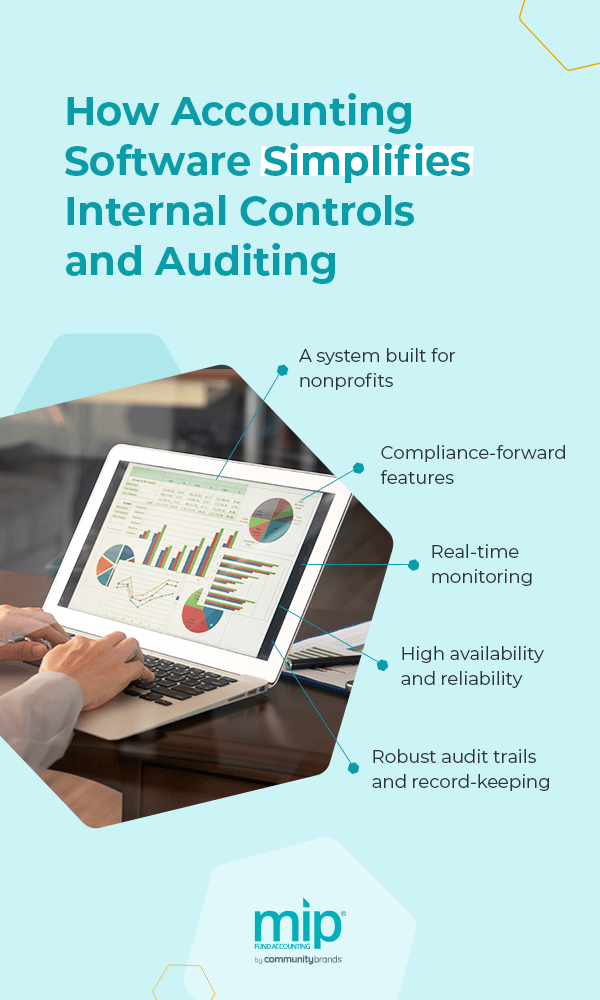Customer Support
How Robust Internal Controls Can Leverage Your Accounting Software for Better Audits

Reading Time: 9 minutes
For nonprofits, regular financial audits are integral to success and needed to comply with federal regulations, impress donors and grantors, or make smarter financial decisions. However you benefit from audits, strong internal controls can greatly reduce their complexity and improve accuracy.
Internal controls help build validity for your financial data, allowing you to perform more reliable, useful audits. Since most financial activities now occur digitally, your accounting software can facilitate many internal controls and use them to improve audits in various ways.
What Are Internal Controls?
Internal controls refer to the mechanisms used to ensure the accuracy and reliability of data. In accounting, these controls cover financial processes and systems. Typically, internal controls prevent or detect problems in accounting operations:
- Preventive: Preventive controls aim to stop problems before they occur, reducing data entry errors and minimizing fraud opportunities. For example, only allowing specific, authorized personnel to access your accounting system is a type of preventive control. Other examples might include verification steps or dividing responsibilities among different employees.
- Detective: Detective controls focus on identifying errors once they’ve occurred. You might use them to find anomalies via regular inventory counts or audits, for instance.
After identifying a problem, you can use corrective controls to mitigate damage, rectify the error, and prevent issues in the future. Corrective measures might include making adjustments or reconciliations or implementing new policies and procedures. Whichever form they take, internal controls are essential for preventing errors and fraud. In one study from the Association of Certified Fraud Examiners (ACFE), a significant portion of all occupational fraud happened due to a lack of internal controls.
By using these different types of internal controls, nonprofit organizations can create a comprehensive approach to fighting fraud and providing reliable, accurate financial records. Implementing controls can also help with internal processes, allowing you to find inefficient systems or those with other areas for opportunity.
Why Audits Are Important for Nonprofits
Some industries, like the nonprofit sector, rely heavily on audits. Audits performed by independent certified professional accountants (CPAs) are well worth the effort to provide an array of benefits. Here are a few examples:
1. Improved Accuracy and Value
Audits help ensure that your financial records are accurate and complete. Having the right figures lets you understand your full financial picture and make more informed decisions. Your data becomes more reliable, and the audit process itself helps you identify errors or fraud before they cause more serious problems.
2. Regulatory Compliance and Grantor Requirements
While state laws can vary widely, the federal government — along with some grantors and lenders — may require an audit for your nonprofit organization. Completing audits efficiently is essential for staying compliant, avoiding penalties or fees, and accessing necessary funds. Proper record-keeping and data entry will also affect compliance for nonprofits.
You may need audits to comply with industry regulations, such as:
- Generally Accepted Accounting Principles (GAAP): GAAP applies to government organizations, nonprofits, and publicly traded companies. These organizations must follow rules for accounting practices that center around 10 principles, such as the principle of consistency, which requires using consistent standards between financial reporting periods. GAAP supports more reliable, standardized, and accurate financial reporting to improve understanding and prevent dishonest practices.
- The Sarbanes-Oxley Act (SOX): SOX is another major regulation nonprofits must meet. Introduced in 2002, SOX helps to prevent interference in a financial audit and maintain an audit’s independence from the organization. It also places more responsibility on board members for conducting effective audits. SOX covers several other topics, such as whistleblower protection and record-keeping requirements.
- The Uniform Administrative Requirements, Cost Principles, and Audit Requirements (Uniform Guidance): Uniform Guidance helps government entities provide funding to financially sound organizations, often requiring audits whenever a nonprofit receives federal funding.
- International Financial Reporting Standards (IFRS): While the U.S. uses GAAP, many countries outside of it use IFRS, which has a similar goal. These standards support consistency and data integrity for accounting processes worldwide, creating a common way to understand accounting information.
Regulations and standards such as these often require regular audits and specific financial processes that go with them. The National Council of Nonprofits offers a helpful guide to state audit requirements for nonprofits in the U.S.
Even if you don’t need to perform audits to meet regulations, you will likely need them to meet grant requirements. Many grantors and creditors ask applicants to supply audits to prove that they have effective processes and can use grant funds appropriately and with less risk of fraud, errors, or oversights.
3. Increased Transparency and Accountability
Nonprofits have a responsibility to use donor funds effectively. Donor trust is essential for securing funds, and audits can help build that trust. Financial audits help you provide more transparency and show accountability for your processes. Auditing supports your relationships with donors and the public, telling them you have nothing to hide. Many stakeholders like to see audits, which can build their confidence through evidence from an independent party on your financial stability.
A nonprofit watchdog like CharityWatch may even review audits to assess your organization’s trustworthiness — successful audits can help show your commitment to your cause and demonstrate your ability to make a difference without wasting funds.
4. Operational Insights
Even if your audits never reach the public, they can still provide valuable information about your organization. For example, audits may reveal errors and fraud or find gaps in your processes that increase the risk of these problems. They can tell you where you might need more internal controls or highlight inefficiencies.

Audits provide a wealth of information about your finances and the nonprofit as a whole. Your team can make more informed decisions and eliminate guesswork with a clear picture of the organization.
Internal Controls in Auditing
CPAs evaluate many elements of a nonprofit during the auditing process, including the efficacy and accuracy of the organization’s internal controls. To pass an audit, the organization’s internal controls should appropriately protect various financial processes. In the U.S., auditors evaluate these aspects through an internal control over financial reporting (ICFR) assessment. ICFR statements attest to a nonprofit’s ability to keep financial data safe from fraud, inaccuracies, and misrepresentation.
CPAs in the U.S. often evaluate ICFR via a standardized framework from the Committee of Sponsoring Organizations of the Treadway Commission (COSO). The framework reviews controls from several perspectives, including strategy, operations, reporting, and compliance. It also assesses varying entities, from individual functions to the whole organization.
The ICFR auditing process usually starts with a risk assessment — which helps the auditor determine the next steps — and a deep dive into regulations and organizational objectives. Once the auditor understands these components enough to provide a qualified opinion, they can assess the nonprofit’s controls for deficiencies and inefficiencies. With the COSO framework, they will assess the following five components, exploring how the controls support the organization’s overall success and risk for fraud and errors.
1. Control Environment
The control environment refers to the organizational culture surrounding internal controls. For example, do managers treat these controls as unnecessary “red tape,” or do they discuss control measures as valuable tools to prevent misuse of funds and further the organization’s mission?
How does the administration approach training requirements, such as education on the motivations behind control measures? Without a proper explanation, employees may not take controls seriously or perform them properly. Instead, managers could provide full transparency. Leaders might also affect the control environment through shared responsibility, by encouraging all members of the nonprofit to contribute to ethical and accurate financial processes — not just supervisors or accounting teams.
These situations offer a few examples of how culture can affect internal controls and a nonprofit’s financial security. Auditors assess a control environment through elements such as the organizational structure, accountability, staff competency, and commitment to ethics and integrity.
2. Control Activities
Control activities focus on the actual tasks and systems used to reduce fraud, errors, and other problems. They must exist at all levels of the nonprofit, from individual processes to organization-wide initiatives. Some examples include access restrictions, audit logs, approval processes, reconciliations, and documentation systems.
3. Risk Assessment
An auditor will review a nonprofit’s approach to risk assessment and whether it adequately evaluates potential concerns. Catching fraud and errors calls for a comprehensive understanding of internal and external factors that could prevent your organization from recording, monitoring, processing, or otherwise interacting with financial data securely and effectively. Strong risk assessment procedures can help you strengthen possible weak spots and know where to look for issues.
For example, if you use manual or paper-based accounting processes, accuracy might be a top concern. As you explore updated software systems, you could prioritize accuracy with more frequent verifications or reconciliation steps.

Risk assessment should also incorporate your organization’s goals. If you aim to grow your staff significantly in the next year, access controls and training may need special attention to prevent problems due to rapid scaling. With a thorough risk assessment process and framework, nonprofits can better implement effective internal controls.
4. Monitoring Activities
Like most organizational systems, regular monitoring helps ensure continued efficacy as your nonprofit’s needs and risks evolve. From changing organizational goals to global disruptions, many factors can affect your susceptibility to fraud and errors. The demands for today’s nonprofits have changed drastically from even a decade ago. Auditors review your monitoring practices to make sure you evaluate the continued success of internal controls.
You can use ongoing or separate evaluations to ensure all components of your ICFR work as intended. You’ll need defined criteria and an effective system for implementing timely corrective action.
5. Information and Communication
Poor communication tactics can make or break an otherwise strong approach to internal controls in nonprofit accounting. This part of the evaluation reviews your methods for collecting and processing information and relaying it to the appropriate people. Your internal controls should:
- Give employees easy access to information on correct procedures.
- Outline clear lines of communication, including a two-way flow of information.
- Outline responsibilities for each party and facilitate contact between employees.
With elements like these, your nonprofit can better ensure high-quality financial data and quick responses when issues appear. You create less space for problems to fall through the cracks, and you can speed up problem-solving decisions with up-to-date information on the organization’s financial status.
IT General Controls
IT general controls (ITGC) are another crucial component of ensuring the security and integrity of financial nonprofit data. Many regulations, including SOX, require ITGC to mitigate cybersecurity risks. Alongside ICFR, the COSO framework also applies to ITGC. Another popular approach to ITGC is the Control Objectives for Information Technology (COBIT), established by ISACA.
Some elements that fall under ITGC include:
- Access control: From encryption to multifactor authentication, many technical safeguards can prevent unauthorized access to confidential data.
- Data backup and recovery: These practices help ensure you do not lose crucial information due to various types of data loss, like a cybersecurity breach or flood.
- Segregation of duties: Segregating duties puts different employees in charge of various tasks and responsibilities, mitigating errors, fraud, and conflicts of interest by providing secondary oversight. For instance, an employee who creates a report or issues a payment shouldn’t be the same one who approves it.
How Accounting Software Simplifies Internal Controls and Auditing

With so many financial tasks occurring through digital systems, your accounting software plays a crucial role in your ability to implement and maintain proper internal controls. It also helps you perform audits more efficiently and effectively — you can confidently get positive results to show to grantors, donors, and other interested stakeholders without hefty costs or time commitments.
Here are some ways your accounting software can help facilitate strong internal controls, streamline auditing processes, and improve results:
- A system built for nonprofits: Nonprofits have unique financial structures, and general-purpose accounting software can fall short of meeting these demands.
- Compliance-forward features: One of those demands is complex compliance requirements. Nonprofit accounting systems can help you meet requirements and quickly generate necessary documentation, such as GAAP-compliant reports and view-only access for auditors.
- Real-time monitoring: You may have many programs, funding sources, and teams, each of which changes quickly. Look for a program that can help you proactively monitor for issues and enact rules that automatically help you prevent fraud and errors.
- High availability and reliability: A cloud-based accounting program from a reliable provider can help improve data security with off-site management and data backups. It also makes your information always available via an internet connection.
- Robust audit trails and record-keeping: Audit trails keep permanent logs of every time someone accesses or modifies data. With a robust audit trail system and other record-keeping tools, you can better ensure compliance, prevent fraud, and improve accountability.
Request a Demo Today and Get Audit-Ready

With the right internal controls, your nonprofit can better prevent fraud and errors while staying audit-ready. Through MIP Fund Accounting, you can maintain compliance, ensure efficiency, and obtain audit results that help you secure more funding for your organization’s mission. From the trusted experts at Community Brands, MIP comes with customized services for your organization’s unique needs.
We have a legacy of experience with nonprofit organizations. Choose from cloud-based or on-premise options and gain access to robust internal controls and auditing features like audit trails, compliant reporting, and a structure designed for nonprofits. Request your demo today to see MIP in action and explore how it can help you improve your organization’s finances.
Share this post




